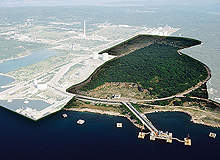
Adria LNG Project is one of the biggest strategic investments being made in the Republic of Croatia. The project involves construction of a liquefied natural gas (LNG) terminal in Omisalj on the northern Adriatic island of Krk.
The terminal will re-gasify LNG received from various suppliers through 100 LNG tankers. During the first phase of the project, the terminal will have a re-gasification capacity of 10 billion cubic meters per year (bcm/y). The processing capacity will be expanded to 15bcm/y during the final phase.
The re-gasified LNG will be supplied to Croatia, central and south-eastern Europe, and Italy through a new pipeline system. An investment of €800m is expected to be made in the project. Construction of the new pipeline system will bring the total cost of the project to €1bn.
The project was first proposed in 1992 and a new company named Adria LNG was formed in 2007 to study the feasibility of building a new terminal. In 2008, the feasibility study for the project was completed.
In July 2009, Adria LNG submitted the environmental impact study (EIS) to the Ministry of Environmental Protection, Physical Planning and Construction. The EIA process was finalised in March 2010 with the EIA Certificate issued by the Ministry.
Adria LNG filed the location permit application in May 2010 and the permit is expected to be granted by the end of the year.
Completion of the project was originally scheduled for 2014 but was delayed due to an oversupply of natural gas in the market.
A final decision on the investment will not be made before 2013 and consequently the project cannot be completed before 2017.
Infrastructure
The Adria LNG terminal will include LNG unloading facilities, LNG storage tanks and tank pumps. The LNG unloading facilities will include four 16in unloading arms, one 40in unloading line and a 28in vapour return line.
As part of phase one of the project, two LNG storage tanks with a capacity of 195,000m³ will be installed at the terminal. Another 195,000m³ storage tank will be installed in phase two of the project.
Three tank pumps with a capacity of 720m³/h each will also be installed at the facility.
In addition, vaporisation equipment and temporary storage facilities will be part of the terminal.
The vaporisation equipment will include two LNG boil off gas (BOG) compressors with a capacity of 7,000m³/h, 10 high pressure pumps with a capacity of 400m³/h each, 10 open rack vaporisers of 32.5MW each and seven sea water pumps with a capacity of 8,700m³/h each. A BOG re-condenser is the option for the second phase of the project.
The terminal will be able to handle LNG carrier sizes ranging from 75,000m³-265,000m³. Depending on the size of the ship the unloading rate will be 12,000m³-16,000m³/hr.
A pipeline system will transport natural gas from the terminal to existing pipelines.
Site
About 12 locations in the northern Adriatic were short-listed for the construction of the new terminal. The selection criteria included maritime traffic, visual impact, infrastructure and connection to the pipeline. Based on these criteria, Omisalj was finalised as the location of the new terminal.
Omisalj offered several advantages in terms of the depth of the sea, access to the gas network and limited environmental impact. Omisalj is also suitably located with regard to the suppliers in the Middle East and North Africa.
Partners
Adria LNG comprises a consortium of companies including E.ON Ruhrgas (39.17%), Total (27.36%), OMV (32.47%) and Geoplin (1%). RWE was also part of the consortium but withdrew from the project as it wanted to focus on other LNG projects in northern Europe. RWE’s 16.69% share in the project was distributed evenly among the remaining shareholders.
Croatian electricity company HEP and gas transport system operator Plinacro formed the LNG Hrvatska consortium to take an 11% interest in the project, while the Croatian oil company INA is expected to take the remaining 14% interest, representing a 25% stake reserved in total for Croatian companies.


